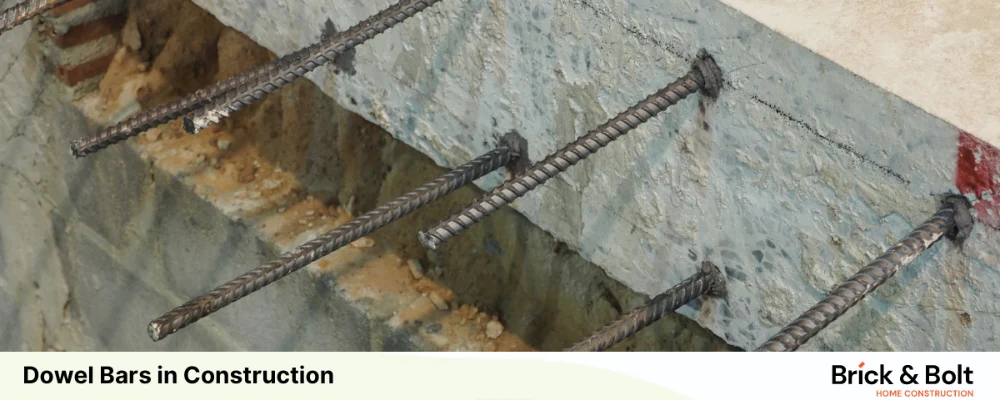Dowel bars are common materials used in the construction industry as reinforcement for concrete structures. They are crucial as they are durable, provide stability, and transfer load evenly throughout the structure. Dowel bars are widely used in concrete pavements. This blog explains the role and specifications of dowel bars.
Dowel Bars
A dowel bar is a short steel bar used in the installation of concrete slabs. The main application of the dowel bar is to provide mechanical support to the slabs without restricting the horizontal joint movements. They also maintain load transfer and balance the weight.
Size of Dowel Bars
Dowel bars are generally 32 to 38 mm (1.25 to 1.5 inches) in diameter, 18 inches (or 460 mm) long, and are spaced at intervals of 305 mm (or 12 inches). However, the figures may differ depending on regional standards and specific project requirements.
Purpose of Dowel Bars in Construction
Dowel bars are used in construction for several purposes, mainly to improve joint performance and load distribution. Some of the purposes of dowel bars are explained below:
- Dowel bars enhance the structural stability of the construction as they distribute weight across concrete joints.
- Dowel bars help minimize deflection and stress at the joints, leading to lesser joint deflection.
- Dowel bars are flexible. This is a crucial factor as the concrete expands and contracts due to changes in moisture and weather.
- Dowel bars decrease joint cracking and faulting.
- The Dowel bar elevates the load transfer efficiency between adjacent slabs.
Overall, dowel bars are primarily used in construction to provide strength to the building.
Types of Dowel Bars
There are different types of dowel bars depending on their application. Some of the types are explained below:
Round Dowel Bars
This is the general type of dowel bar. They are made from a high-strength steel bar that has a diameter between 12 mm to 32 mm.
Square Dowel Bars
The square dowel bars resemble the round dwell bars. However, they have a square cross-sectional area instead of the round one. A square dowel bar is particularly used in areas where high load capacity is needed.
Fiberglass dowel bars
These bars are new types of dowel bars that are made using composite materials. These materials are lightweight and have low thermal expansion compared to steel bars.
Placement of Dowel Bars
The placement of dowel bars should be done by following the steps mentioned below:
- The bars should be in a standard 90-degree angle with the centerline.
- On each side of the dowel, there should be at least one and a half inch gap, and a new channel should be carved.
- The dowel bars are placed across the concrete pavement’s transverse joint. This is because the movement of the concrete happens at this place.
- To restrict the bonding to PCC(Portland Cement Concrete), the middle slab should be covered with a bond-forming substance.
- As the dowel bears load, the adjacent slabs should have enough room to expand and contract.
Method 1 of Placing a Dowel Bar: The first method includes placing the dowel bar and pouring concrete on top of it. This is a successful procedure that increases bonding, is cost-effective and doesn’t require additional chemicals.
Method 2 of Placing a Dowel Bar: It is a costly and long process. In this method, a hole is drilled and Hilti chemical is used for strong bonding. This is used when placing an extension bar is forgotten before concreting.
Advantages of Dowel Bar
The advantages of dowel bars are listed below:
Transfer of Load: Dowel bars facilitate load transfer between adjacent concrete slabs, thus reducing the stress on the pavement and preventing the formation of cracks.
Joint Stability: The stability of the joints is increased between the concrete slabs, ensuring the surface level is maintained without faulting.
Longevity: The lifespan of the concrete can be increased, and hence the pavements remain durable without cracks or other damages.
Disadvantages of Dowel Bars
The disadvantages of dowel bars are explained below:
Cost: Dowel bars are costly, specifically the high-strength steel dowel bar.
Complex Installation: Dowel bar installation needs experts and equipment; hence, they are complicated and time-consuming.
Corrosion: Dowel bars in harsh environmental conditions are susceptible to corrosion.
Maintenance of Dowel Bars
Dowel bars should be maintained for the longevity and integrity of the structure. The important aspects of the maintenance of dowel bars are explained below:
Inspection: Dowel bars need to be inspected frequently to identify any damage. Check signs for cracks, corrosion, or any dislocation in the area.
Cleaning: Dowel bars should be regularly cleaned to prevent any debris settlement that leads to damage. High-pressure water can be used to clean the area.
Lubrication: Lubrication decreases corrosion. Hence, the dowel bars should be installed after thorough lubrication to ensure smooth movement between the slabs.
Replacement: Damaged or bent dowel bars should be replaced promptly; prolonged use of damaged dowels can lead to more significant issues and higher repair costs.
Conclusion
Dowel bars play an important role in maintaining the durability and functionality of concrete pavements and other constructions. Dowel bars have incredible applications in improving joint stability, load transfer between concrete slabs, and increasing the lifespan of the concrete structure. Dowel bars do have some disadvantages; however, they are brilliant materials for concrete pavements and other applications.
FAQs
Dowel bars help evenly distribute loads across concrete slabs, reducing differential movement and stress that can lead to cracking.
The diameter of dowel bars is generally 16 mm to 50 mm. They can be supplied in strength grades such as 250, 500, and 600, as mentioned in BS 6744:2016.
The size of a dowel pin can be measured using a caliper. This determines the diameter and end-to-end length of the dowel pin along with the crowns.

